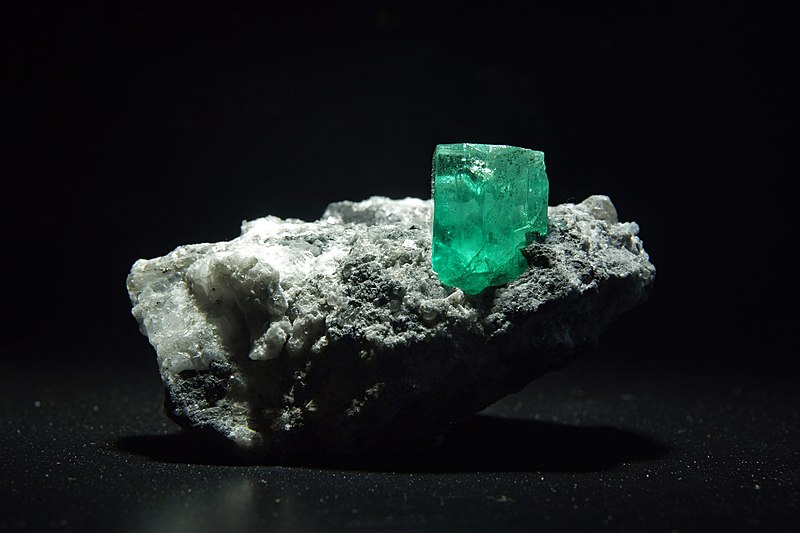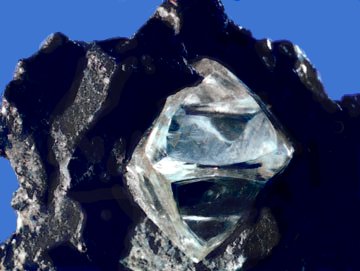 |
| Ruby crystal on calcite photo by Rob Lavinsky |
Gems have been prized for thousands of years, for their
color, luster, durability, hardness and their high intrinsic value per
volume. They are found in all kinds of
geologic environments of all ages from thousands of million years to recent
times. Gemstones are also found in all
kinds of rocks ranging from igneous to metamorphic to sedimentary and are
classified according to the environment where they were formed. The deposits are rare because of the
geological conditions needed to form them are exceptional. For example, in order for the Emerald to form
the beryllium from which it is made has to come in contact with chromium or
vanadium. These elements travel in
entirely different geochemical circles that are the exception rather than the
rule.
It is important to realize that like any other commodity,
gems are subject to the laws of supply and demand. Even though the demand for gems remains about
the same the supplies are becoming depleted.
Many of the gems especially the colored variety are mined in Third
World countries by artesianal methods, i.e. by hand. In any of these countries the discovery of
the new deposit often leads to a local prosperity, but many of these stones
become involved in the illegal trade that is being used to finance terrorism.
These deposits of gemstones are volcanic in origin and are
formed deep within the Earth’s crust.
Gemstones from this origin have formed over 100 Km below the surface and
are brought to the surface as the result of magma intrusions or lava
flows. Diamonds are one type of this
deposit that has formed from 100 to 150 Km below the surface. These gemstones are found in potassium rich
stone called “kimberlite” that is brought to the surface in an explosive eruption
that proceeds at near supersonic speeds. There seems to be a rule known as
Clifford's rule that these eruptions take place in Achaean terranes or come up
through younger terranes overlying Achaean terrenes. Kimberlite is quite rich in peridot and appears
to be full of xenoliths that are torn off the walls of the magma channel. A cross-sectional view of the kimberlite is
like looking at a carrot. The stone
itself is quite soft and easily eroded away with the diamonds being carried
away with the rest of the erosion products.
Diamonds are not the only product that is found in a
magmatic deposit so are others stones such as sapphires and zircons. Sapphires are also formed under some very
specific geological conditions the most important one is a magmatic stone that
is low in primary silicates such as basalt.
The sapphires form as crystals in the basalt and they're released as
products of erosion. Although they form
in the basalt they are rarely mined directly.
Zircons are another example of a gemstone that is found in a magmatic
deposit. Once again these gemstones are
not mined directly from the stone that are found as the products of
erosion. In geology zircons are thought
to be forever and the oldest dated minerals in the world are some zircons that
were found in Western Australia
that were dated at 4.5 billion years old.
Zircons are used by geochemists worldwide for dating formations of
different ages, and are highly effective in this use.
Some other gemstone minerals that are found in magmatic
deposits include:
Peridot, gem quality olivine usually found in mantle
xenoliths.
Labradorite, found as gem quality grains in some basalts.
Zircon, found as crystals in granite, basalt and the rarer
carbonatites.
Apatite, found as crystals in carbonatites.
Garnets, found as crystals in basalts as xenocrysts and
granite.
Pegmatites are hydrothermal deposits contain more different
types of gemstones in any other rock.
These are formed from the volatile rich fluids that are found in
pegmatites when they are formed. In some
geological circles pegmatites are called “Giant granite” because they have the
same minerals as granite except the crystals of the individual minerals are
much larger. There are two different
kinds of pegmatites simple and complex; most of the valuable minerals are found
in complex pegmatites. Although many of
these minerals could be classified as gems other minerals found in pegmatites
are the ores for rare metals such as niobium or rare earths.
Depending on the fluids present when the pegmatite is
solidifying different gemstones are deposited.
If the fluid is rich in fluorine topaz will be deposited. A beryllium rich fluid will produce the
mineral beryl in its many forms ranging from aquamarine, emerald, morganite, or
heliodor. Lithium rich fluid is another
possibility depositing spodumene or other lithium rich minerals. Pollucite is deposited from a cesium rich
fluid. In some cases the fluid is rich
in several different elements producing “Tourmaline” a gemstone that is
actually rarer them diamonds. A
manganese rich fluid will cause spessertine garnet to be deposited.
There are specific zones in a pegmatite where gemstones are
found. Many of them are found in
cavities called “Vugs.” The crystals formed
in this environment are usually clear and well formed. A deposit of this nature containing red and
green tourmaline was discovered in the 1970s at Newry ,
Maine
There are other hydrothermal environments that are also
capable of producing gemstones ranging from volcanic rocks to sedimentary
rocks. This is where one is likely to
encounter agates, petrified wood, opal, amethyst as well as a whole plethora of
gems. Turquoise is another mineral
deposited by hydrothermal waters. It is
copper phosphate and its beautiful sky blue botryoidal masses have been admired
for over two thousand years.
Jade is another mineral that is found in high-pressure; low-pressure blue schist metamorphic rocks. There are two entirely different minerals that are recognized as jade in the trade one of these as jadeite a compact variety of the mineral pyroxene, and the other is nephrite a compact variety of the mineral that is derived from tremolite. Although these minerals are composed of common minerals it takes a very special environment for them to form.
Sedimentary deposits:
By far the most valuable gemstone found in sedimentary rock is precious opal. The largest deposits of this mineral in the world are found in central Australia. Other deposits are found in the United States and Mexico. Most opal is found as a replacement for fossils. Opal also occurs as replacement beds or blebs in sedimentary rock. A good piece of opal showing good colors can be as expensive as a diamond.
Placer deposits:
In some placer deposits gemstones are relatively abundant particularly in areas where the local rocks are known to produce gemstones. This is especially true in areas underlying by cordierite gneiss or marble. Another area is where gemstone bearing pegmatites are abundant. Because of their toughness and hardness gemstones that are eroded from their country rock tend to remain intact preserving the best gemstones. The same rough and tough treatment these stones go under as a result of natural processes particularly running water the weaker and softer stones are broken up leaving behind the highest quality gemstones. Most of the gemstones in the world are recovered from placer deposits. In some cases the work of recovery can be quite primitive; in others the most modern technology and machinery is used.
References:
Mineralogical Association of Canada, Editor Lee A. Groat, Geology Of Gem Deposits, Short Course Series, Volume 37, Yukon Geological Survey, © 2007, Yellowknife, Northwest Territories
Gem Deposits, http://amonline.net.au/geoscience/earth/gem.htm
Geology of Gem Deposits, Mineralogical Association of Canada, Editor Lee A. Groat, http://www.mineralogicalassociation.ca/doc/promo_SC37.pdf Volume 37 © 2007



Impressive details within your post sharing for the knowing of gemstones deposit. Thanks a lot. Kalpana Srikaanth astrologer | Pancharatna gems Coimbatore
ReplyDeleteNice post, Your given information is very useful. Thanks for Sharing this informational blog post. Please keep it up. For more detail click this hyper link Tourmaline Specimens For Sale
ReplyDelete